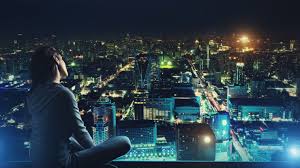This October, millions of Americans missed out on witnessing two of the most spectacular celestial events—the northern lights and a rare comet. The culprit? Light pollution. As the night sky continues to grow brighter, with a 10% increase annually since 2011 across North America, a new wave of research is revealing a disturbing trend: the excessive artificial light flooding our environment may be tied to a surprising number of health issues, including cancer, heart disease, diabetes, Alzheimer’s disease, and even poor sperm quality.
The Vanishing Night Sky
The glow of urbanization has erased our ability to experience true darkness. A shocking 80% of people in North America can no longer see the Milky Way. John Hanifin, PhD, associate director of Thomas Jefferson University’s Light Research Program, explains, “We’ve lost the contrast between light and dark, and we are confusing our physiology on a regular basis.” The consequences extend beyond the aesthetic loss of starlight, with scientific evidence suggesting that light pollution is a serious public health issue.
While indoor exposure to blue light from phones and screens has long been linked to sleep disruption, studies now show that outdoor light pollution can wreak havoc on health, too. One recent study found that people living in the brightest-lit areas at night had a 31% higher risk of high blood pressure, a 29% higher risk of death from coronary heart disease, and a 17% higher risk of stroke or other cerebrovascular conditions.
How Light Pollution Affects the Body
The human body operates on a circadian rhythm—a roughly 24-hour cycle that governs processes such as sleep, metabolism, and hormone production. Light at night, whether from street lamps, illuminated billboards, or even dim household lighting, can disrupt this natural rhythm. Exposure to artificial light at night suppresses melatonin, a hormone crucial for regulating sleep, immune function, and inflammation. Even low levels of light—less than 30 lux, akin to the glow of a streetlight—can reduce melatonin by half, making the body more susceptible to diseases.
Research shows that this disruption can have far-reaching effects. For example, melatonin plays a key role in cancer defense by activating natural killer cells, which help destroy cancer cells. When melatonin levels drop, the risk of breast cancer and other malignancies increases. Studies also suggest a strong connection between nighttime light exposure and neuroinflammation, potentially explaining the link between light pollution and Alzheimer’s disease.
The Emerging Science on Health Risks
In recent years, the body of evidence connecting light pollution to major health conditions has grown. A 2024 study involving more than 13,000 people showed that those living under brighter skies were significantly more likely to develop high blood pressure. Another study from Hong Kong highlighted a similar trend, revealing a 29% higher risk of coronary heart disease mortality among residents of highly illuminated areas.
Light pollution is also being linked to metabolic disorders such as diabetes. A study in China estimated that light pollution could be responsible for 9 million cases of diabetes, underscoring the global scale of this health risk.
What Can Be Done?
Protecting ourselves from light pollution isn’t easy, but there are steps we can take. Simple measures like investing in blackout curtains, reducing screen use at night, and planting trees around our homes can help mitigate the effects. On a broader scale, advocating for better outdoor lighting policies—such as dimmer streetlights and reduced building illumination—can make a difference.
As scientists continue to uncover the far-reaching impacts of light pollution on human health, the call to preserve darkness becomes increasingly urgent. By reducing unnecessary artificial light, we not only protect our health but also preserve the awe-inspiring beauty of the night sky, potentially fostering a sense of well-being and connection to the universe.











